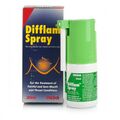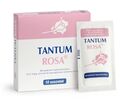Benzydamine
| Summary sheet: Benzydamine |
| Benzydamine | |||||||||||||||||||||||||||||||
|---|---|---|---|---|---|---|---|---|---|---|---|---|---|---|---|---|---|---|---|---|---|---|---|---|---|---|---|---|---|---|---|
| Chemical Nomenclature | |||||||||||||||||||||||||||||||
| Common names | Benzydamine, Tantum Verde | ||||||||||||||||||||||||||||||
| Substitutive name | Benzydamine | ||||||||||||||||||||||||||||||
| Systematic name | 3-(1-Benzyl-1H-indazol-3-yloxy)-N,N-dimethylpropan-1-amine | ||||||||||||||||||||||||||||||
| Class Membership | |||||||||||||||||||||||||||||||
| Psychoactive class | Deliriant / Stimulant | ||||||||||||||||||||||||||||||
| Chemical class | Indazole | ||||||||||||||||||||||||||||||
| Routes of Administration | |||||||||||||||||||||||||||||||
|
|||||||||||||||||||||||||||||||
| Interactions | |||||||||||||||||||||||||||||||
Benzydamine (also known as Difflam or Tantum Verde) is a topical anaesthetic of the indazole chemical class. It is sometimes found in small doses in over-the-counter products used to treat sore throats. In Germany, Arabic Countries and Poland, it is sold as a vaginal douching agent under the brand name Tantum Rosa. This product is also easily accessible across the world through the use of online stores such as eBay.
Alternatively, benzydamine can be used as a powerful psychoactive hallucinogen for recreational purposes. In high doses, it acts as a unique deliriant and CNS stimulant.[1] Such use, particularly among teenagers, has been reported in Poland,[1] Brazil[2][3] and Romania.
Chemistry
Benzydamine is a synthetic compound with the chemical formula C19H23N3O. It belongs to the class of compounds known as indazoles, which are bicyclic structures made up of a benzene and pyrazole ring fused together.
In the case of benzydamine, the indazole group is further substituted with a benzyl group (C6H5CH2-) at the R1 position. This means that one of the carbon atoms in the benzene ring of the indazole group is replaced by the benzyl group. At the R3 position of the indazole group, there is an ether chain consisting of an oxygen atom bonded to a propyl amine group. This propyl amine group is a chain of three carbon atoms and one nitrogen atom, with the nitrogen atom bonded to two hydrogen atoms (NH2).
The terminal amine group of the propyl amine chain (RN) is substituted with two methyl groups (CH3), resulting in the final chemical structure of 3-(1-benzylindazol-3-yl)oxy-N,N-dimethylpropan-1-amine.
Benzydamine is usually produced as a hydrochloride salt, which means that a hydrochloric acid molecule (HCl) is added to the benzydamine molecule to form a salt. The hydrochloride salt is often used in pharmaceutical formulations due to its better solubility in water and increased stability compared to the free base form of benzydamine.
Pharmacology
Benzydamine is a locally acting nonsteroidal anti-inflammatory drug with local anaesthetic and analgesic properties. Unlike other NSAIDs, it does not inhibit cyclooxygenase or lipooxygenase and is not ulcerogenic.
In terms of the pharmacology behind its hallucinogenic effects, this aspect of benzydamine remains unstudied and is subject to much speculation.
Benzydamine has a powerful reinforcing effect and that this effect is greatly facilitated in animals that already had substance experience, having previously self-administered heroin and cocaine, indicating cross sensitization between benzydamine and other common drugs of abuse. Benzydamine dose-dependently reduced both field excitatory post synaptic potential amplitude and paired pulse ratio, suggesting a presynaptic mechanism of action. Similarly to the in vivo paradigm, also the electrophysiological effects of benzydamine were potentiated in slices from animals that had undergone cocaine and heroin self-administration. Furthermore, benzydamine-induced Long Term Depression (LTD)-like responses in the prelimbic cortex-to-nucleus accumbens circuitry were significantly reduced in the presence of the CB1 receptor antagonist AM251. These findings provide firm evidence of the abuse liability of benzydamine and suggest a possible cannabinoidergic mechanism of action.[4]
Subjective effects
 |
This subjective effects section is a stub. As such, it is still in progress and may contain incomplete or wrong information. You can help by expanding or correcting it. |
Physical effects 
-
- Stimulation - Residual stimulation and insomnia may last up to 48 hours after initial dosing of this substance. The taxing nature of having gone through the deliriant trip and the following sleep deprivation is likely to cause paranoia.
- Abnormal heartbeat
- Tactile suppression
- Increased heart rate
- Motor control loss
- Gustatory hallucinations
- Dehydration
- Frequent urination
- Dizziness
Visual effects 
-
- External hallucinations (autonomous entities; settings, sceneries, and landscapes; perspective hallucinations and scenarios and plots)
- Visual acuity suppression
- Drifting
- Object alterations
- After images
- Visual haze
- Geometry
- Double vision
- Pattern recognition suppression
- Vibrating vision
- Peripheral information misinterpretation
- Shadow people
- Unspeakable horrors
- Object activation
Cognitive effects 
-
- Anxiety
- Euphoria - Felt during onset but fades as the trip peaks.
- Depression
- Delirium
- Time distortion
- Thought acceleration
- Delusions
- Feelings of impending doom - Replaces Euphoria
- Paranoia - Replaces Euphoria
- Psychosis - Especially common after high doses or multiple doses taken in a short space of time
Auditory effects 
Experience reports
Anecdotal reports which describe the effects of this compound within our experience index include:
Additional experience reports can be found here:
Toxicity and harm potential
The vaginal douching agents such as Tantum Rosa and other products consistently contain large amounts of salt which, if consumed, can cause serious kidney damage.
The toxicity and long-term health effects of recreational benzydamine use do not seem to have been studied in any scientific context and the exact toxic dose is unknown. This is because benzydamine is a research chemical with very little history of human usage. Anecdotal evidence from people within the psychonaut community who have tried benzydamine suggests that there are no negative health effects attributed to simply trying the drug by itself at low to moderate doses and using it very sparingly (but nothing can be completely guaranteed). Independent research should always be done to ensure that a combination of two or more substances is safe before consumption.
Extraction
Benzydamine is usually extracted from Tantum Rosa douching agents which are available online. In order to consume the substance safely, one must first remove the dangerous levels of salt contained within the sachet. This can be done by dissolving the substance in a small amount of water (25ml/sachet). After the substance has mostly dissolved after stirring (warm or just boiled water works best as the salt will dissolve more easily), wait 10 minutes. After 10 minutes has past the benzydamine should have formed a layer on the top and the salt have settled at the bottom. The benzydamine should be filtered out using filter paper but do not pour the salt that may settle at the bottom as this will simply add back most of the salt you have tried to remove. It is best to consume the remaining paste by stirring it into very strong squash and drinking it.
Legal status
Benzydamine is legal and available in over-the-counter preparations in most parts of the world.
See also
External links
- Benzydamine (Wikipedia)
- Benzydamine (Isomer Design)
- Benzydamine (Taimapedia)
- Benzydamine (Bluelight)
- Benzydamine (Drugs Forum)
- Benzydamine (Reddit)
References
- ↑ 1.0 1.1 Anand, J. S., Glebocka, M. L.-, Korolkiewicz, R. P. (2007). "Recreational abuse with benzydamine hydrochloride (tantum rosa)". Clinical Toxicology (Philadelphia, Pa.). 45 (2): 198–199. doi:10.1080/15563650600981210. ISSN 1556-3650.
- ↑ Opaleye, E. S., Noto, A. R., Sanchez, Z. van der M., Moura, Y. G. de, Galduróz, J. C. F., Carlini, E. A. (September 2009). "Recreational use of benzydamine as a hallucinogen among street youth in Brazil". Revista Brasileira De Psiquiatria (Sao Paulo, Brazil: 1999). 31 (3): 208–213. doi:10.1590/s1516-44462009000300005. ISSN 1516-4446.
- ↑ Mota, D. M., Costa, A. A. da, Teixeira, C. dos S., Bastos, A. A., Dias, M. F. (May 2010). "Uso abusivo de benzidamina no Brasil: uma abordagem em farmacovigilância". Ciência & Saúde Coletiva. 15 (3): 717–724. doi:10.1590/S1413-81232010000300014. ISSN 1413-8123.
- ↑ Avvisati, R., Meringolo, M., Stendardo, E., Malavasi, E., Marinelli, S., Badiani, A. (March 2018). "Intravenous self-administration of benzydamine, a non-steroidal anti-inflammatory drug with a central cannabinoidergic mechanism of action". Addiction Biology. 23 (2): 610–619. doi:10.1111/adb.12516. ISSN 1369-1600.


